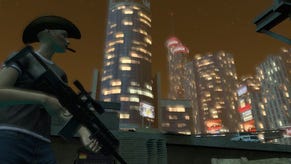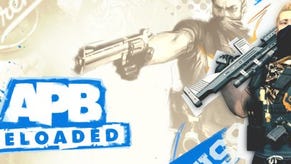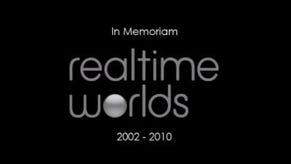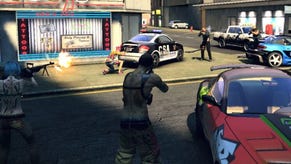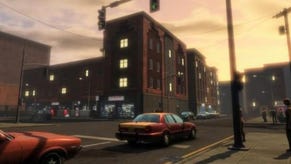Citizens On Patrol: Arnold Tsang's APB
Fashion Shooter
This is the latest in the series of articles about the art technology of games, in collaboration with the particularly handsome Dead End Thrills.
Not only can I straightfacedly say that I enjoyed playing APB, I even have this document to prove it. Being what felt like a voice in the wilderness back then wasn't what was frustrating, though, it was knowing that the trolls so vocal in the game's own chat channels weren't wrong. Such were this MMO shooter's problems - the anarchy not just of game, you felt, but production - that no amount of charity was going to save it from the bloodlust of gloating critics.
As someone who loves a good character editor and was floored by APB's ambition, I had a hard time dealing with the bait-and-switch of the game's customisation modes. (What you built in the editor looked next to nothing like who you played in the game.) Clearly the game couldn't deal with it, either, which is why much of its landscape is wallpapered in the work of a concept art dream team assembled by Webzen and Realtime Worlds.
Whatever the intention was, those billboards featuring the same sassy designer punks as the boxart are a stinging reminder of what this game was supposed to achieve. Just like real adverts, then, they dangle the dream to keep you on the treadmill, hoping the next item reward will finally make you cool. But it never does. In this and many other ways, APB is the most Korean game ever made in Scotland.
Many, if not most, of those characters are the work of Blizzard concept artist Arnold Tsang, perhaps better known as co-founder of gaming art collective the Udon Crew. His deviantART portfolio is loaded with APB creations, some of the first of his career.
DET: How did you come to work on APB?
Arnold Tsang: I joined when it was still being published by Webzen. They’d formed a small team in Korea to work on the project alongside Realtime Worlds, and we’d visit their Scotland office about twice a year. I joined out of college with my roommate Andrew Hou [aka nJoo]; we had another friend from college who was already working at Webzen at the time, and were somehow able to convince them to hire us both.
Webzen was hot off the success of MU [Online] at the time, and had hired almost every big-name Korean concept artist in the industry - except Hyung-tae Kim. I learned a lot from just watching what these other teams in the company were doing, the techniques of these Korean masters.
DET: How much of a concept of APB’s characters did RTW have when you were approached?
Tsang: I wouldn’t say it was left up to us - me and Andrew - it’s more like there was a lack of direction at the time we came on board. So it just so happened that whatever we drew started to give the project a little more focus. There was another concept artist on the Korean team at the time, Huh GeunHwa. GeunHwa helped us a lot, breaking us into the team, and Korean culture in general.
Before we joined there was a little bit of concept art, but I guess we brought the more fashiony hip flavour to the style. Before, it was just straight-up cops and robbers. What I saw was very much just police cars and guys with the blue uniforms and hats shooting at gangsters. We started to make things a little more ambiguous. Characters like De La Rocha, one of the Enforcers, he had attitude whereas before there wasn’t too much character to the factions. We pretty much had no idea what we were doing and just started drawing the coolest cops and robbers we could think of, bouncing ideas off of Jon Stockwell, who was the concept artist at Realtime Worlds. Jon was great and really helped us jam out the style even though we were across multiple continents.
DET: Presumably you can’t have one faction be cooler than the other in a PvP scenario, either.
Tsang: Yeah, that’s pretty much it. It’s easy to make the gangsters cool, but then everyone wants to play the bad guy. You play GTA and you’re playing the bad guy, so we definitely wanted to give the Enforcers some mojo.
DET: How did you appeal to different territories with the characters? In terms of taste, for instance, where does the Korean market stop and the US market begin?
Tsang: It wasn’t so much the design of the characters, it was more the art style itself. I guess that’s why they hired me: I was a western-based artist but some of my art had an eastern flavour to it. I think that was naturally the best way for APB to appease both markets. Around the time we got hired, around 2005, I don’t think Korean games had been totally popularised worldwide yet, but it was getting there and the art in particular was making a splash.
If you look at the western view of Asian games at that point, it was mostly Japanese games, and a lot of the Japanese style is very anime, very cartoony. If you look at the western style, a lot of times it’s very realistic and less dynamic. But then you get the Korean art style which I feel is a natural bridge between the two. You get the stylisation and the aesthetics of the Japanese-influenced art styles but they’ll put in a more realistic, rendered western look. You saw a lot of that in Korean games, and that philosophy is what we were going on as well.
DET: One way to sum up the characters of APB would be ‘beat-em-up characters with guns’. There’s the attitude and fashion of a Final Fight, with characters like Poison, but something significant's been added to the equation.
Tsang: I actually hadn’t thought of that. I love Final Fight but it wasn’t a conscious choice to take that and add guns. But now you mention it, you might be right. There’s even a character who’s very much like Poison.
DET: The Capcom style comes naturally to you, then.
Tsang: It’s in my blood, man, I can’t shake it off. It’s probably the greatest influence in my artistic career. But one thing I would add is that before working on APB, in most of the stuff I’d done the rendering style was less realistic. That was something new I tried. Even though it doesn’t come off as totally realistic, it’s more so than Street Fighter or anything else I’ve done in that vein.
DET: The poses are crucial to these designs, to the point where the in-game versions tend to be locked to a single idle pose.
Tsang: It’s definitely part of the package. I know some of the poses, the anatomy’s probably all broken and stuff, but part of it is just me being a noobie in the game industry. Nowadays when I design a character, I know I’m going to do it in a pretty neutral pose where you can see from a pretty good angle, like three-quarter, everything about the character so the information is there for the modeler. But since APB is the first game I worked on, it was like, ‘Let’s just make cool illustrations of these characters.’ I wasn’t thinking too much about the modeling and just wanted to push the pose every time.
That’s definitely something that comes from Capcom. Every time you look at the artwork they have for any Street Fighter game, all the characters are displayed in such unique poses, so iconic. That’s something I always strive for. Every time you think of that character, you see the pose; and every time you see the pose, you think of the character. It’s very true for fighting games both in the concept art and the game.
All of the NPCs in APB were made in the character customisation suite, I believe, so any exaggerated poses had to use that one male and female model they had. So a lot of posing and proportions wouldn’t come through. They had the male and female bodies pretty established even when we were doing the concepts, so there was a mistranslation there. There wasn’t any relation between the models and the concepts, and so it was more like fashion or costume design: you put the costumes on really elongated characters but when the model puts it on, the inspiration is there but the look is completely different. That’s kind of how I saw our job.
I didn’t have any ideas of how they would translate our work into realtime because there are all kinds of different concept artists: there are the costume designers and the ones where the game’s art style is based on the drawing. That’s definitely not what APB was - or, at least, if that’s what they were trying then they didn’t pull it off. It’s hard to do. Not many teams pull it off.
DET: Did you work much with [RTW art lead] Jimmy O’Ready as that famous character editor came together?
Tsang: Jimmy came on about a year after we’d joined the team, and he really started to focus our efforts a little more. We started to understand what our drawings were going to be used for, and our work became more production than pre-vis. Jimmy also helped us put names and backstories to a lot of the characters we designed, and slowly their personalities came out.
DET: Why does a character like Sofia look like she does? Where does this oddly branded, consumerist punk come from?
Tsang: There’s a Japanese fashion magazine called Kera, and there’s a sub-magazine from that called Kera Maniax. They were Japanese post-punk fashion where they took a lot of the punk aesthetics but made it more mainstream, more designed. A lot of my inspiration came from those. Coming from Canada - this is going to sound really weird - when you go along the street, people don’t really dress up. You walk down the street in Korea and girls are wearing miniskirts; fashion is just a lot more prevalent. But you won’t see much of the punk style in Korea, that’s more Japanese.
DET: It’s quite an apocalyptic style, too, or at least post-millennial. Everything’s been done so just throw it all together.
Tsang: There’s definitely a lot of that. The initial way of doing it was having these fashion bases to begin with, then throwing on stuff like pouches, grenades, gun holsters, bandoleers, and stuff. An attitude started developing from that, the idea of having bullets actually be fashion. It’s not done too much. Another huge inspiration that springs to mind is John Galliano, the fashion designer. He does a lot of the crazy stuff like that where he’ll take a theme like ‘Military Dudes’ or ‘Samurai Fashion’.
DET: MMOs are heavily ‘accessorised’ games full of items and micropayments. Does that influence the costume design?
Tsang: That probably happened accidentally, actually. But I guess it does work out like that: if you throw a bunch of stuff on the characters then it makes the customisation more robust.
DET: The girls-with-guns genre has a history in both Korea and Japan. Where did you look for reference?
Tsang: It was just getting photo reference of girls handling guns - even though in movies they probably do it the wrong way. There was this one website I remember called Girls With Guns or something like that. It just had images from movies where there were girls using, holding, posing with, guns. It’s more of an attitude than a 1:1 visual reference. It’s Kate Beckinsale’s face in Underworld, the way she’s holding the gun; it was that kind of energy we wanted to capture.
DET: Were the weapons and characters inseparable? Did they inspire each other?
Tsang: Well, some of the weapons are customised a little bit more. Aces, the character with the Uzi has a custom magazine, and there’s dangling stuff on there. As for the types of weapons they’re holding and how that relates to their personality, I dunno, not really. It was whatever looked cool. ‘What gun haven’t we done yet? Oh, we haven’t done an Uzi. Let’s do an Uzi.’ Sometimes the poses were influenced by the guns and sometimes it was whatever fits.
Udon Entertainment and its exquisite art books can be found here. APB: Reloaded, now in the hands of GamersFirst, is free-to-play and lives here.








